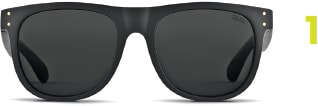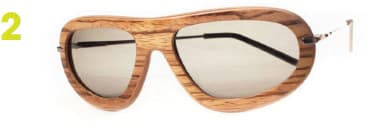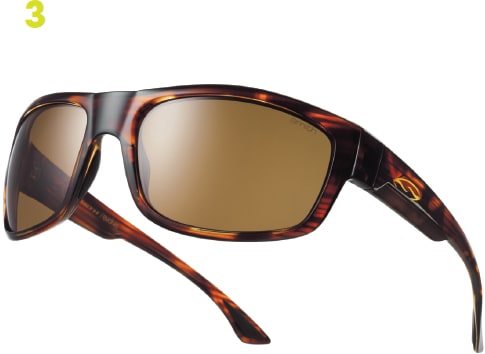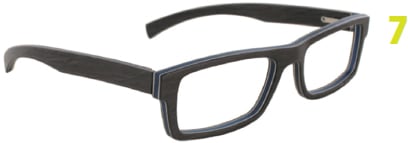Greentailing 101
Bringing eco-friendly frames into the dispensary for added profits—plus a roundup of the latest in bio-based, biodegradable, and greener eyewear options
By Erinn Morgan
Does green still matter at retail? According to the 5th Annual Tork Sustainability Study released in June, the answer is a resounding “yes”—U.S. consumers are actually increasing their purchases of eco-conscious products.
A full 78 percent of U.S. consumers say they buy green products and services, according to the study, a notable increase over the 69 percent of 2012.
“There are lots of vendors that make great sustainable products, but green is not necessarily the shiny new toy at retail that it was a few years ago,” says Daniel Butler, vice president, merchandising and retail operations at the National Retail Federation. “Today, for retailers looking to increase profitability, sustainability makes sense where the customer will value it.”
GREEN IN OPTICAL
In optical, eyecare professionals say that eco-friendly products are a growing force. “The world’s not getting any bigger and we’re running out of more resources every day, so choosing green products ensures our future is here tomorrow,” says Frank Gimble, ABOC, and owner at Gimble Eye Associates in Wayne, PA. “There’s also a rapidly growing consumer group that only wants green eyewear products.”
The key is that consumers see increased value in products with eco-conscious aspects, such as recycled or bio-based materials. “The green focus of the eco eyewear line we carry is an added bonus to customers,” says Nithinee Schneid, office manager at Takoma Park Vision in Takoma Park, MD, and Uptown Vision in Washington, DC, who notes that she sees a lot of eco-conscious consumers in the neighborhood. “The people who are conscious of the environment recognize the value right away. People who are not as conscious see it later and they also like it.”
At Seattle-based Wink Eyewear, owner/optician Michele Bayle says customers also see value in companies that do good by giving back. “Our customers love the fact that the Drift Eyewear line we carry gives one percent of their profits back to the planet through the nonprofit 1% for the Planet. As society becomes more and more attuned to green products, they are also aware of the related charitable programs out there. Connecting them to programs that speak to them is fantastic.”
Does a desire for eco-friendly products—and the companies that make them—equate to a willingness to spend more on green items? The jury is still out on this aspect of selling eco-conscious products, as 43 percent of Americans say they would pay more, while 44 percent say they would not, according to the Tork Sustainability Study. “Our patients do like the green focus but, in the end, they buy our eco-friendly frames because they like the style and the price,” says Schneid.
Still, with the right products at the right price, green can be good business for ECPs today. “Keeping your boutique fresh with green products is great marketing,” says Bayle. “Don’t be afraid to try something nobody else has tried yet in your area.”
BRINGING IN GREEN
How can you successfully add eco-focused products to your frame mix? Here, some expert tips from veteran ECPs with a vested interest in a more sustainable product mix.
Slow and Steady Wins the Race:
Greener ECPs recommend bringing new, more sustainable products into your mix in a slow and methodical manner. “It’s difficult and expensive to make very large-swing adjustments in your inventory approach,” says Gimble. “Gradual adjustments are easier than diving in with both feet.”
Thus, he suggests taking a year to slowly add in more and more eco-friendly products until you have your desired percentage. At Gimble Eye Associates, that number is 10 percent.
“I knew that amount would work in our system, our displays, and with our margins,” he says.
“Most opticals only stock an average of about 800 pieces, and most optometric practices don’t have financials to be too aggressive. So it’s wise to go in slowly, adding in three to four percent here and there, and then you’ll be at 10 percent by the end of year one,” he adds.
Make a Green Statement: At Seattle’s Wink Eyewear, Bayle’s eco-friendly eyewear mix accounts for a slightly higher 12 to 15 percent of her frame assortment. “I’d recommend a minimum of 15 to 24 pieces of a collection; a lot of the eco-conscious and recycled collections are small to begin with,” she says. “But you have to put enough product in to tell a story. Less than 15 pieces doesn’t tell a story and it doesn’t say anything to the shopper.”
Thus, Bayle suggests committing to at least 18 to 24 pieces to get started.
Gimble agrees. “In order to let your patients know you have this product you have to have enough of it,” he says. “Prove to your patients that you are committed to this line and provide the reasoning why.”
Market Your Green Prowess to the Community: Once you’ve got your green product assortment in place, Bayle suggests getting the word out via advertising and events.
“Put the information up on your social media channels, send out informational postcards and share stacks of them with local merchants, and host a green event that spreads the word,” she says, noting that she’s also created product displays that utilize green elements like recycled items and wood.
“Show people that you are cognizant of the footprint that manufacturing puts on the world,” she adds.
At the same time, make sure your staff is well equipped to explain the merits of your green frame products.
“Ask for help from the frame representatives to train the staff on what makes their products green,” says Gimble. “Ask them to book a company lunch or offer one-on-one training in a coffee house or in the optical. The more knowledge [staff has] about the product, the better.” EB
| Green Inspiration |
|---|
|
Technology and eco-consciousness have collided in today’s greener eyewear products, with everything from the world’s first plant-based lenses to bio-based and recycled frame materials taking center stage. Here, we highlight a selection of eco-conscious eyewear companies and their new products that are pushing the boundaries of green today. ZEAL Optics 1 WHO THEY ARE: This sunglass maker has made a company-wide commitment to eco initiatives, from engineering the latest in biodegradable frames and plantbased lenses to its Project 5480, which plants trees in areas of need through the non-profit American Forests. GREEN PRODUCT: The company recently launched e-llume in a selection of its products, a sunlens that ZEAL says is the world’s first plant-based lens—it’s crafted of castor oil from Switzerland, lenses from Japan, and a polarized film that cuts glare and delivers sun protection. Even more recently, ZEAL debuted the ACE, a stylehoned, biodegradable sunglass made from cotton grown in the USA—another first for this innovative company. On the Web: zealoptics.com 
iWood Eco Design 2 WHO THEY ARE: This eyewear maker focuses on frames made of eco-conscious reclaimed exotic wood used for the interiors of private luxury jets rather than plastics derived from petroleum products. All woods are certified and harvested by sustainable methods and all glues and coatings used in frame assembly are free of formaldehyde and Volatile Organic Compounds (VOC). All frames are also made in the United States. GREEN PRODUCT: This fall, iWood debuts a new hand-burnished polymerized finish. Using 18th-century rubbing techniques with oil pressed from seeds of the flax plant, the micro-laminated veneers have a deep, durable, and natural finish that is safe for skin contact. On the Web: iwoodecodesign.com 
Smith Optics 3 WHO THEY ARE: This sports and fashion sunglass maker has put a spotlight on the environment by offering what it calls “the largest eco-friendly eyewear collection in the world.” GREEN PRODUCT: Smith crafts the lion’s share of its products—including those with its recently launched color-optimizing ChromaPop lens technology—with its Evolve frame material, which is 53 percent bio-based and derived from non-GMO castor plants. On the Web: smithoptics.com 
Stella McCartney 4 WHO THEY ARE: This upscale collection of eyewear and sunwear from Luxottica also has eco credibility. It features an acetate plastic that is made of 54 percent natural and renewable sources, including biodegradable cellulose and citric-acid derived plasticizers. GREEN PRODUCT: The latest eco-oriented Stella McCartney collection includes style-honed colors and shapes ranging from oversized butterfly looks and modern, wide squares to thin rounded shapes. On the Web: luxottica.com/en/brands/license-brands/stella-mccartney 
Eco Eyewear 5 WHO THEY ARE: Founded in 2008 by Modo CEO and founder Alessandro Lanaro, Eco is touted as “the first and only optical and sunglass collection made with 95 percent recycled materials.” To confirm its claim, Eco applied for and received an Environmental Claims Validation from UL Environment (ULE), a wholly owned subsidiary of Underwriters Laboratories (UL), a world leader in product evaluation. The respected ULE validation substantiates Eco’s assertion that its eyewear is made with 95 percent recycled stainless steel and plastic. Eco also plants a tree for every frame sold. GREEN PRODUCT: Fashion is at the fore of this eco-conscious eyewear collection, which debuted a Fall ’13 Eco 2.0 “Skinny Collection” that features wearable, geek chic, ultra-thin recycled plastics that have a stainless steel core for added flexibility. On the Web: eco-optics.com 
Reptile, Inc. 6 WHO THEY ARE: All of this eyewear maker’s plastic frames are made from a Mazzucchelli zyl material crafted with cotton fiber. There are no petroleum-based plastics used here. In addition, glass lenses are used throughout the collection and all colors used on these plastic frames, which are also hypoallergenic, are derived from vegetables and minerals. Green efforts are also key to business; Reptile Sun recycles nearly 100 percent of its waste in the office. GREEN PRODUCT: New bio-based styles from Reptile include the big, bold, retro Woma, a 60s-inspired Jackie O sunglass. The company also recently debuted eyeOs Eyewear, a fashion-oriented reading glasses collection that is made from acetate that is made from cotton. On the Web: reptile-polarized-sunglasses.com and eyeoseyewear.com 
Gold & Wood 7 WHO THEY ARE: This luxury eyewear maker has a commitment to sustainable development in manufacturing and procurement of raw materials. This includes horn taken from healthy domesticated animals, minimal use of FSC-certified wood in settings (e.g., a thousand temples can be made from one tree), and a manufacturing process certified green by Luxembourg’s Ministry for the Environment. GREEN PRODUCT: Gold & Wood recently debuted Omega Eyepiece, which features new combinations of materials, colors, and finishes. It also celebrates the development of the new assembly process of alternating wood veneers, aluminum, and horn under hyperbaric pressure. On the Web: gold-and-wood.com 
|



